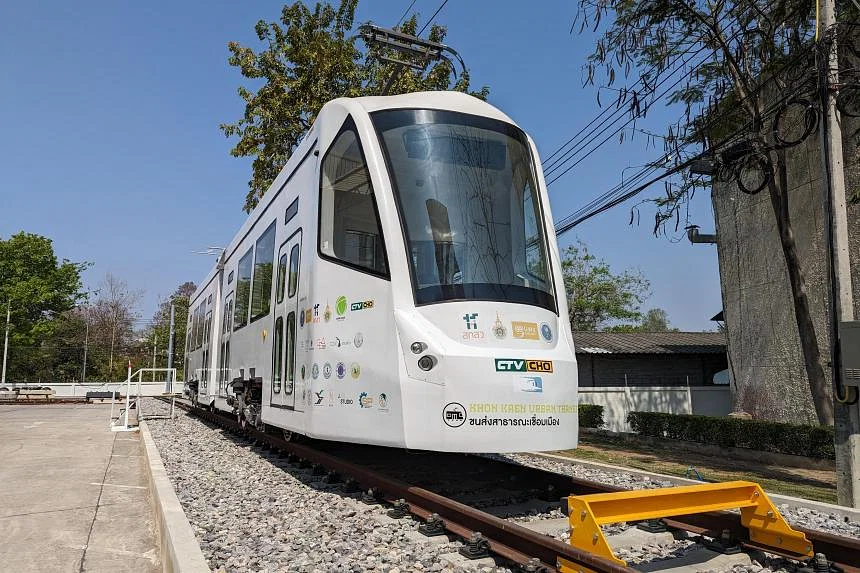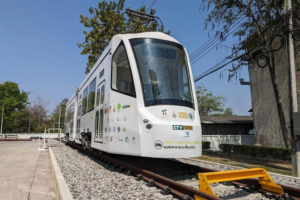
Thailand’s first urban rail network outside of Bangkok to be built from 2024 in Khon Kaen
An ambitious plan to build the first urban rail network outside of Bangkok will come to fruition in the north-eastern city of Khon Kaen. Work will begin in 2024 on a 26km light rail system to run through the city.
The long-awaited public transport system, first proposed eight years ago, fits in the province’s larger Smart City Development Programme, which has more than 100 projects in the pipeline. The light rail system will also link up with the mega high-speed railway running from China and Laos into Thailand.
The 21 billion baht (S$813 million) project is more than just a solution to traffic congestion. It also breaks ground on the idea that provinces can have the autonomy to pursue large-scale projects without relying on Bangkok’s central government to spearhead such initiatives.
“For a project like this, people usually rely on the central government to plan and lead it. But here in Khon Kaen, we saw the pain points of the city,” said Mr Suradech Taweesaengsakulthai, 57, president and chief executive of transport and manufacturing company Cho Thavee.
Mr Suradech is a founding member of the Khon Kaen Think Tank (KKTT), one of the local groups that helped to broker the approval of the project with the central government.
Under Thailand’s highly centralised governing system, the national government has a tight hold on federal purse strings and resources are typically concentrated in the capital Bangkok or cities targeted for development.
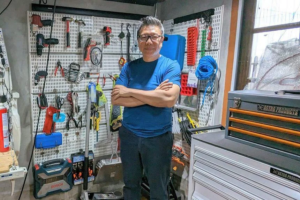
The successful approval and start of the light rail project in a secondary province like Khon Kaen represent a decentralising of developmental processes and resource distribution, said public administration lecturer Jackrit Kamudhamas from Khon Kaen University.
“It represents a lot more than a transport system. It represents the fight against unequal distribution of resources between capital and regional cities,” said Mr Jackrit.
Khon Kaen has a population of nearly two million people and is not a typical foreign tourist destination. However, it has undergone rapid development from an industrial area into a regional hub for financial, educational and administrative activities, and is now plagued by traffic congestion and urban density issues like in Bangkok.
It is also home to Khon Kaen University, which has more than 40,000 students.
In the past decades, Bangkok has built up an intensive grid of mass rapid transport nodes that cover more than 200km, with several extensions in the works. However, it is the only Thai city with such mass transit to date.
Instead of waiting for funds and resources to be disbursed to their city, residents like Mr Suradech decided it was time to act independently, even if it meant putting up their own funds.
The KKTT was formed by 20 local businessmen, academics and community leaders.
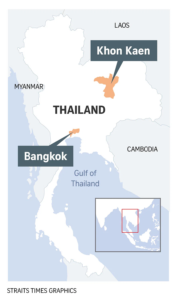 “We have money. So we agreed that we would each put in 10 million baht. If that could develop Khon Kaen for the better, that’s a bet we were willing to make,” said Mr Suradech, adding that the company began in 2015 with a registered capital of 200 million baht for building the city’s infrastructure.
“We have money. So we agreed that we would each put in 10 million baht. If that could develop Khon Kaen for the better, that’s a bet we were willing to make,” said Mr Suradech, adding that the company began in 2015 with a registered capital of 200 million baht for building the city’s infrastructure.
Dubbed the Khon Kaen Model, part of the plan is to establish the light rail network as a backbone for real estate and city development. There are also plans to create employment and a rail industry, in which the knowledge and technology can be sold to others.
Through a private-public partnership with the Khon Kaen Transit System (KKTS), a public company founded by the five Khon Kaen municipalities along the tram line, the large-scale project finally cleared all government red tape in 2018.
The KKTS will own and operate the light rail line. This is similar to the way the existing Krungthep Thanakom company, a state enterprise and investment arm of the Bangkok Metropolitan Administration, handles public transport projects.
While the project does not rely on central government funding, it still requires appropriate government endorsement and support. Representatives like Mr Suradech have spent the past eight years seeking approval from various local, regional and central agencies.
The group had faced scepticism, as some thought their efforts would be viewed as an attempt to subvert the central government, which was at the time led by the military.
“We told the government, at that time the NCPO (National Council for Peace and Order), that this project is different. We just need your approval; we will find the money and run everything by ourselves. So this was key,” said Mr Suradech.
The now-disbanded NCPO was in charge of Thailand from 2014 to 2019. It took four years for the light rail project to pass through several bodies, such as the Ministry of Interior and the Ministry of Transport, before final approval was granted by the Prime Minister’s Office in 2018.
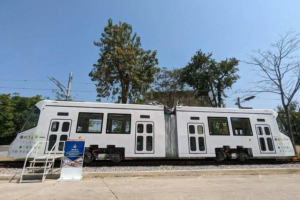
The project is estimated to have an internal rate of return – a gauge of its profitability – of more than 9 per cent, and this will allow the KKTS to borrow funds to back the project.
There are also ambitious plans to eventually list the project on the Stock Exchange of Thailand, where funds raised can be used to sustain the network and back future provincial projects.
With construction on the light rail project expected to begin in early 2024, trams built with the help of Mr Suradech’s company Cho Thavee are currently undergoing trial.
Rather than subvert the central government, the most important aspect is to disrupt the governing processes and allow provinces to embark on initiatives that will benefit their cities, said Mr Suradech.
The potential gains from the Khon Kaen light rail network include an increase in jobs and economic growth of 1.5 per cent, said a study done by the Bank of Thailand.
Other provinces have also started their own versions of the KKTS, and in January 2022, the government said it would fast-track rail projects in six provinces, including in Khon Kaen.
Though the light rail project has had its share of critics since the start, Mr Suradech says he has always seen the light at the end of the tunnel.
“People used to tease us a lot before this, but once Khon Kaen starts piling works and has its opening ceremony, I’m sure people will want to do what we have done,” he said.
Mr Jackrit, a long-time resident of Khon Kaen, admits that he is amazed at how far the project has come, calling its success in gaining approvals from all parties, including the central government, “historic”.
“They have paved the way in terms of thinking outside the box – having a locally-driven billion-baht project was unthinkable before this,” said Mr Jackrit.
Source: https://www.straitstimes.com/asia/se-asia/more-than-just-a-transport-node-this-urban-train-project-breaks-bureaucratic-barriers
